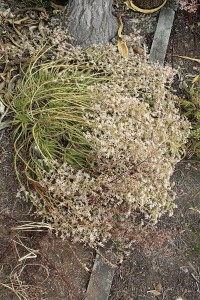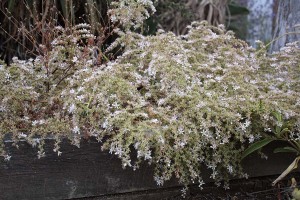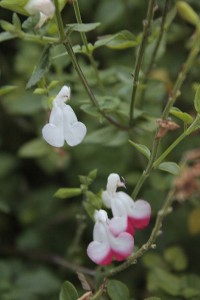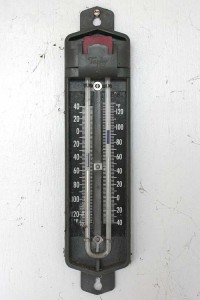It’s been a cool summer so far, following on the heels of a sunny but cool spring. I’ve been watching the temperatures in the paper for Fairbanks, Alaska, and most days the official San Diego report has been cooler. In fact it’s been cooler than almost anywhere in the US except for maybe Anchorage in Alaska. Brr.
At my July 4th party I was talking to someone there with ties to the Scripps Institution of Oceanography, and his thoughts were that this is typical for an El Niño year. The phenomenon that the locals call “May gray” would be slow to get started (as was the case this year), and the dreaded subsequent phenomenon the we call “June gloom” would drag on longer than usual. All that seems to be happening.
The garden natives don’t seem to be worrying about the temperature as much as I’ve been. In fact the late-spring bloomers seem to be having a field day, extending their bloom, looking nice at a time of year when they don’t always. Black sage is often done by this time, but there are a few lingering flowering stems.
For stunning flowers, though, the black sage has passed the baton to Cleveland sage. Here’s the common and gorgeous cultivar ‘Winnifred Gilman.’
…and here’s Winnifred in closeup…
One of local live-forevers, Dudleya edulis, has had one of the more amazing years that I can remember. Here’s an 18-20 year old plant from above, all covered with flowers. In this photo it’s sprawling six feet across from one edge to the other.
The same dudleya, viewed from ground level as it cascades over a short little retaining wall.
The San Miguel Island buckwheat that I grew from seed two years ago, Eriogonum grande var. rubescens, is finally hitting its stride, finally looking the photos I’ve seen in books. Maybe the cooler weather will keep it looking nice longer.
Among the many non-natives that call my garden their home, this is Clerodendrum ugandense, finally perking up after looking like a twig until late in May. I think it’s been a somewhat slow start for this plant this year, but it always waits until the weather warms to look like a plant you want to keep in the garden.
The common ornamental sage, Salvia ‘Hot Lips,’ is grown for its red and white bicolored blooms. I’ve heard that it blooms mostly with white flowers when weather turns cold. In the left photo these are the only two red and white flowers I could find on three plants. The rest of the flowers are white. In the depths of winter, however, this plant is often completely bicolored, so I’m not sure if there’s any truth to this color change rumor.
Some of the plants that I worry about the most are my American pitcher plants, these Sarracenia from the South, where the daily low temperatures these days are often running ten degrees above the San Diego daytime highs. Fortunately these plants seem to respond more to daylength than to temperature, and the plants look pretty good. Still, they might be taller by now where they originate.
Cool as the days may be, one thing told me for sure that I do not live remotely near Alaska. Monday night was the grand opening of the first giant bloom of this climbing cactus, probably Hylocereus undatus. Even if it’s probably been slow getting started this year, it’s probably the best proof that I’m overreacting. Hardy to not much below freezing, one hit of arctic cold and you’ll freeze this plant’s tuchas off.
At eight to ten inches across, the only shy thing about this plant is that it only opens as darkness approaches. People in cold climes covet being able to grow plants like this–or in fact many of our more tender California natives.
That’s definite proof, Dorothy. We don’t live in Alaska. It just might feel that way these cool summer days.












